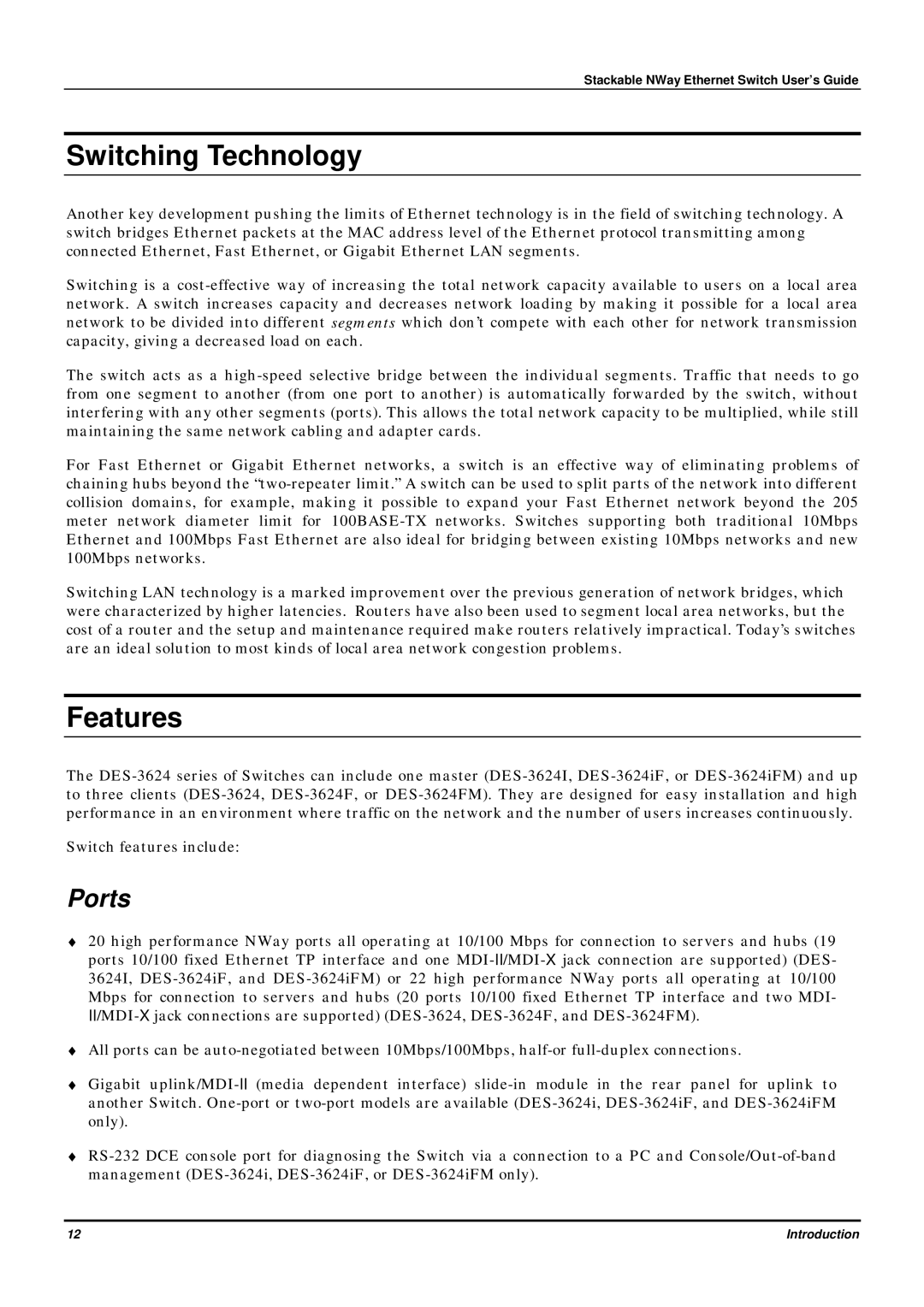Stackable NWay Ethernet Switch User’s Guide
Switching Technology
Another key development pushing the limits of Ethernet technology is in the field of switching technology. A switch bridges Ethernet packets at the MAC address level of the Ethernet protocol transmitting among connected Ethernet, Fast Ethernet, or Gigabit Ethernet LAN segments.
Switching is a cost-effective way of increasing the total network capacity available to users on a local area network. A switch increases capacity and decreases network loading by making it possible for a local area network to be divided into different segments which don’t compete with each other for network transmission capacity, giving a decreased load on each.
The switch acts as a high-speed selective bridge between the individual segments. Traffic that needs to go from one segment to another (from one port to another) is automatically forwarded by the switch, without interfering with any other segments (ports). This allows the total network capacity to be multiplied, while still maintaining the same network cabling and adapter cards.
For Fast Ethernet or Gigabit Ethernet networks, a switch is an effective way of eliminating problems of chaining hubs beyond the “two-repeater limit.” A switch can be used to split parts of the network into different collision domains, for example, making it possible to expand your Fast Ethernet network beyond the 205 meter network diameter limit for 100BASE-TX networks. Switches supporting both traditional 10Mbps Ethernet and 100Mbps Fast Ethernet are also ideal for bridging between existing 10Mbps networks and new 100Mbps networks.
Switching LAN technology is a marked improvement over the previous generation of network bridges, which were characterized by higher latencies. Routers have also been used to segment local area networks, but the cost of a router and the setup and maintenance required make routers relatively impractical. Today’s switches are an ideal solution to most kinds of local area network congestion problems.
Features
The DES-3624 series of Switches can include one master (DES-3624I, DES-3624iF, or DES-3624iFM) and up to three clients (DES-3624, DES-3624F, or DES-3624FM). They are designed for easy installation and high performance in an environment where traffic on the network and the number of users increases continuously.
Switch features include:
Ports
♦20 high performance NWay ports all operating at 10/100 Mbps for connection to servers and hubs (19 ports 10/100 fixed Ethernet TP interface and one MDI-II/MDI-Xjack connection are supported) (DES- 3624I, DES-3624iF, and DES-3624iFM) or 22 high performance NWay ports all operating at 10/100 Mbps for connection to servers and hubs (20 ports 10/100 fixed Ethernet TP interface and two MDI- II/MDI-Xjack connections are supported) (DES-3624, DES-3624F, and DES-3624FM).
♦All ports can be auto-negotiated between 10Mbps/100Mbps, half-or full-duplex connections.
♦Gigabit uplink/MDI-II(media dependent interface) slide-in module in the rear panel for uplink to another Switch. One-port or two-port models are available (DES-3624i, DES-3624iF, and DES-3624iFM only).
♦RS-232 DCE console port for diagnosing the Switch via a connection to a PC and Console/Out-of-band management (DES-3624i, DES-3624iF, or DES-3624iFM only).

